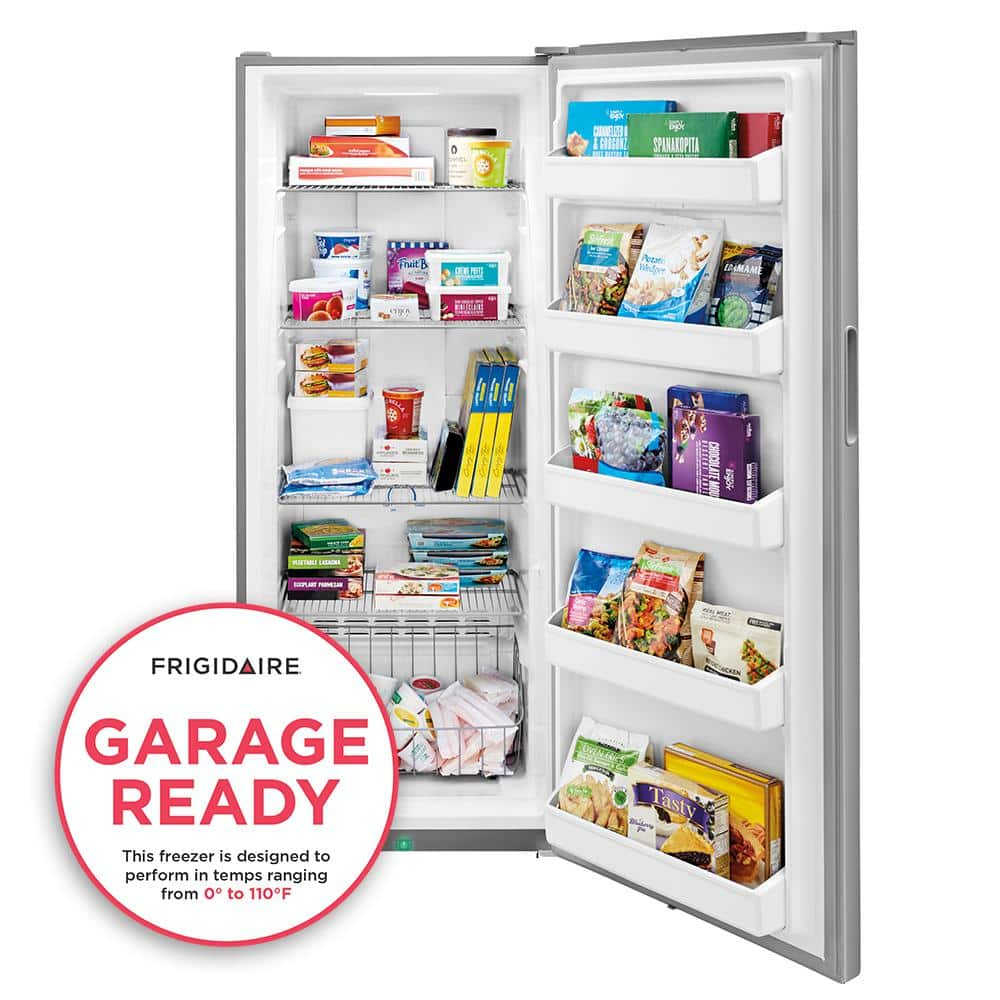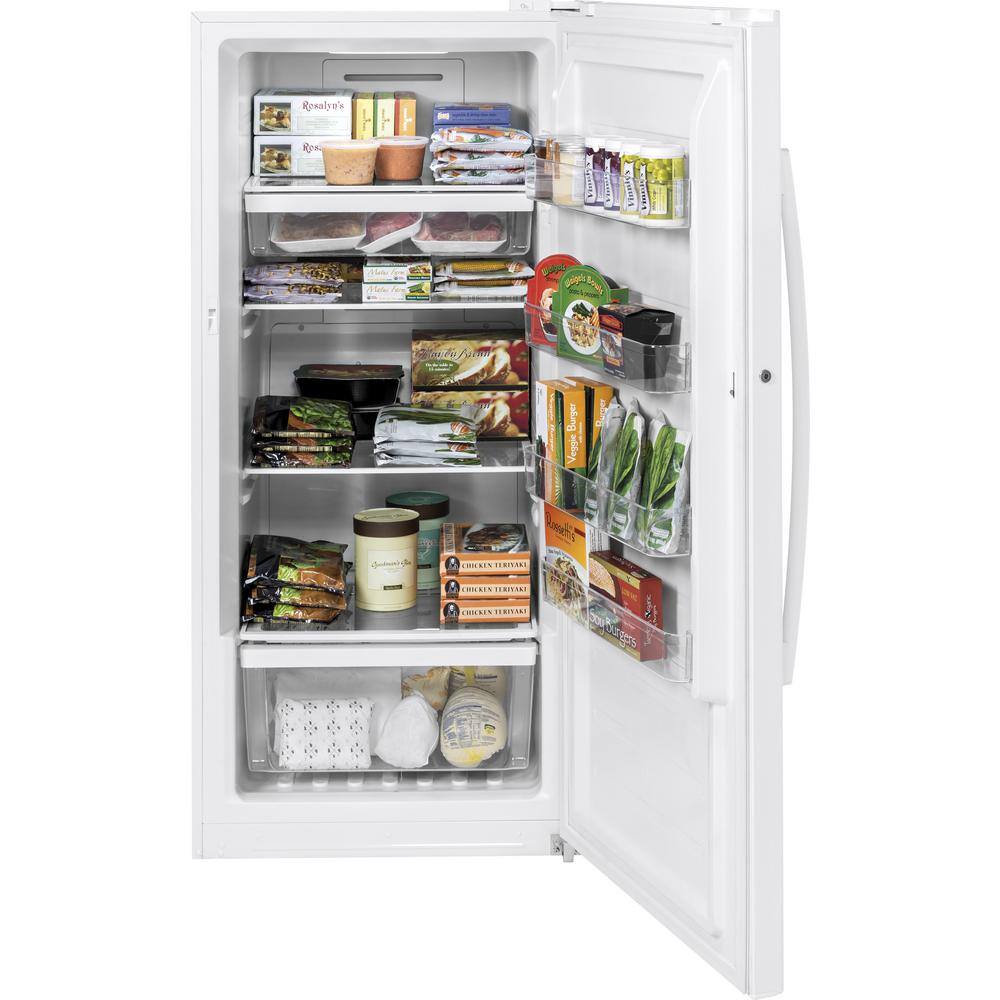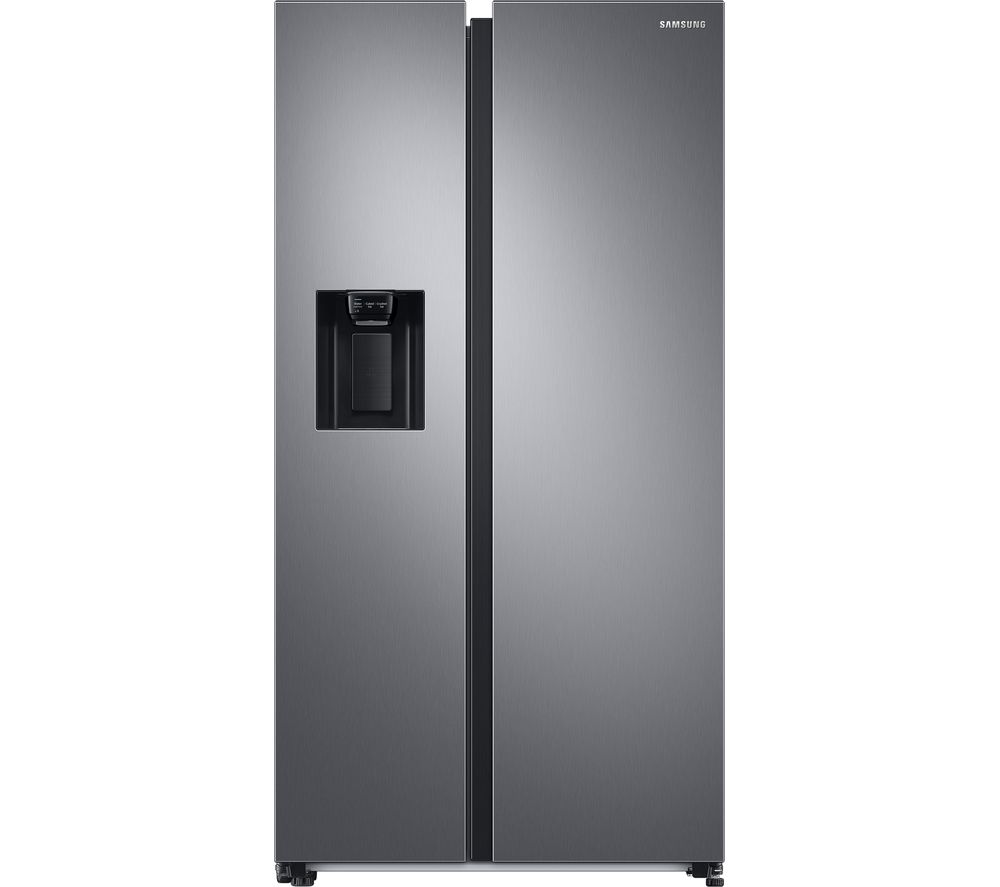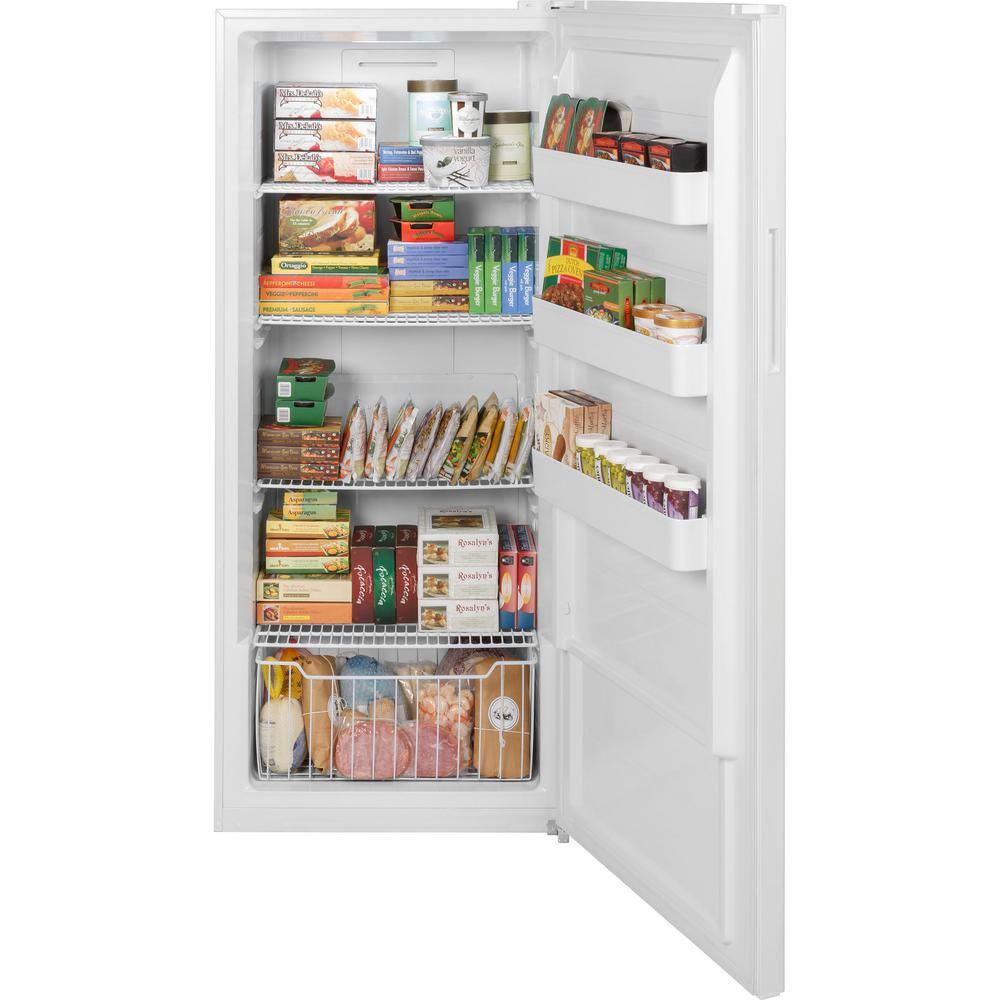Frigidaire 16 cu. ft. Frost Free Upright Freezer in Brushed Steel
Food stays frozen for two days with Power Outage Assurance. Prevent warm spots and unwanted freezing with EvenTemp Cooling. Frost Free Design.
The Frigidaire 16.0 cu. ft. Upright Freezer allows you to conveniently store all of your favorite frozen foods with a variety of ways to organize the interior. Ensure food freshness with a superior tight seal, floor-projected power-on indicator and door ajar alarm. Frigidaire’s EvenTemp Cooling System constantly circulates cold air throughout the freezer with smart sensing technology that adjusts airflow to maintain a uniform temperature, while bright LED lighting ensures you’ll spend less time digging through your freezer for items.
- Flexible interior organization system – Easily organize your family’s frozen favorites with our four adjustable, metallic wire shelves, deep bottom basket, and five spacious door bins that allow you to make the most of every available square inch of your freezer
- Frost-Free Design – Never waste time chipping away ice in your freezer again with our frost-free design that does the work for you
- Power Outage Assurance – Keep food frozen for two days if there is a power outage with our superior tight seal that locks in cold air
- EvenTemp Cooling System – Our EvenTemp cooling system constantly circulates cold air throughout the freezer with smart sensing technology that adjusts air flow to maintain a uniform temperature
- Door Ajar Alarm – Monitor the ideal environment for your frozen foods with our audible temperature alarm that alerts you if the door is left open or the freezer’s temperature rises
- Floor-Projected Power-On Indicator – Know at a glance that your freezer is keeping your favorites safely frozen and fresh with our power-on indicator light
- Internal dial temperature control makes controlling the temperature simple and easy
- Bright LED lighting makes it easy to see what’s inside
- Place this unit in your garage without worry. This unit is designed to perform in temperatures ranging from 0°F to 110°F
Additional information
| Depth (Excluding Handles) | 29.125 |
|---|---|
| Depth (Including Handles) | 29.125 |
| Depth With Door Open 90 Degrees (In) | 55.75 |
| Height to Top of Case (in.) | 67.75 |
| Height to Top of Door Hinge (in.) | 67.75 |
| Minimum Side Air Clearance (In) | 4 |
| Product Depth x Height x Width (in.) | 29.125 x 67.75 x 29.125 |
| Certifications and Listings | UL Listed |
| Warranty Information | One Year Limited |
Sixteen or 16 may refer to:
- 16 (number), the natural number following 15 and preceding 17
- one of the years 16 BC, AD 16, 1916, 2016
Frigidaire Appliance Company is the American consumer and commercial home appliances brand subsidiary of multinational company Electrolux, a Swedish multinational home appliance manufacturer, headquartered in Stockholm.
Frigidaire was founded as the Guardian Frigerator Company in Fort Wayne, Indiana, and developed the first self-contained refrigerator, invented by Nathaniel B. Wales and Alfred Mellowes in 1916. In 1918, William C. Durant, a founder of General Motors, personally invested in the company and in 1919, it adopted the name Frigidaire.
The brand was so well known in the refrigeration field in the early-to-mid-1900s, that many Americans called any refrigerator a Frigidaire regardless of brand. In France, Canada, and some other French-speaking countries or areas, the word Frigidaire is often in use as a synonym today, and in transcribed form in Serbocroatian also ("frižider", "фрижидер"). Although the alliterative names Frigidaire or its antecedent Frigerator suggest an origin of the widely used English word fridge, it is simply a contraction of refrigerator, a word in use since 1611.
From 1919 to 1979, the company was owned by General Motors. During that period, it was first a subsidiary of Delco-Light and was later an independent division based in Dayton, Ohio. The division also manufactured air conditioning compressors for GM cars. While the company was owned by General Motors, its logo featured the phrase "Product of General Motors", and later renamed to "Home Environment Division of General Motors".
Frigidaire was sold to the White Consolidated Industries in 1979, which in 1986 was purchased by Electrolux, its current parent.
The company claims firsts including:
- Electric self-contained refrigerator (September, 1918 in Detroit)
- Home food freezer
- Room air conditioner
- 30" electric range
- Coordinated colors for home appliances
Frost is a thin layer of ice on a solid surface, which forms from water vapor that deposits onto a freezing surface. Frost forms when the air contains more water vapor than it can normally hold at a specific temperature. The process is similar to the formation of dew, except it occurs below the freezing point of water typically without crossing through a liquid state.
Air always contains a certain amount of water vapor, depending on temperature. Warmer air can hold more than colder air. When the atmosphere contains more water than it can hold at a specific temperature, its relative humidity rises above 100% becoming supersaturated, and the excess water vapor is forced to deposit onto any nearby surface, forming seed crystals. The temperature at which frost will form is called the dew point, and depends on the humidity of the air. When the temperature of the air drops below its dew point, excess water vapor is forced out of solution, resulting in a phase change directly from water vapor (a gas) to ice (a solid). As more water molecules are added to the seeds, crystal growth occurs, forming ice crystals. Crystals may vary in size and shape, from an even layer of numerous microscopic-seeds to fewer but much larger crystals, ranging from long dendritic crystals (tree-like) growing across a surface, acicular crystals (needle-like) growing outward from the surface, snowflake-shaped crystals, or even large, knifelike blades of ice covering an object, which depends on many factors such as temperature, air pressure, air motion and turbulence, surface roughness and wettability, and the level of supersaturation. For example, water vapor adsorbs to glass very well, so automobile windows will often frost before the paint, and large hoar-frost crystals can grow very rapidly when the air is very cold, calm, and heavily saturated, such as during an ice fog.
Frost may occur when warm, moist air comes into contact with a cold surface, cooling it below its dew point, such as warm breath on a freezing window. In the atmosphere, it more often occurs when both the air and the surface are below freezing, when the air experiences a drop in temperature bringing it below its dew point, for example, when the temperature falls after the Sun sets. In temperate climates, it most commonly appears on surfaces near the ground as fragile white crystals; in cold climates, it occurs in a greater variety of forms. The propagation of crystal formation occurs by the process of nucleation, in specific, water nucleation, which is the same phenomenon responsible for the formation of clouds, fog, snow, rain and other meteorological phenomena.
The ice crystals of frost form as the result of fractal process development. The depth of frost crystals varies depending on the amount of time they have been accumulating, and the concentration of the water vapor (humidity). Frost crystals may be invisible (black), clear (translucent), or, if a mass of frost crystals scatters light in all directions, the coating of frost appears white.
Types of frost include crystalline frost (hoar frost or radiation frost) from deposition of water vapor from air of low humidity, white frost in humid conditions, window frost on glass surfaces, advection frost from cold wind over cold surfaces, black frost without visible ice at low temperatures and very low humidity, and rime under supercooled wet conditions.
Plants that have evolved in warmer climates suffer damage when the temperature falls low enough to freeze the water in the cells that make up the plant tissue. The tissue damage resulting from this process is known as "frost damage". Farmers in those regions where frost damage has been known to affect their crops often invest in substantial means to protect their crops from such damage.
Steel is an alloy of iron and carbon with improved strength and fracture resistance compared to other forms of iron. Because of its high tensile strength and low cost, steel is one of the most commonly manufactured materials in the world. Steel is used in buildings, as concrete reinforcing rods, in bridges, infrastructure, tools, ships, trains, cars, bicycles, machines, electrical appliances, furniture, and weapons.
Iron is always the main element in steel, but many other elements may be present or added. Stainless steels, which are resistant to corrosion and oxidation, typically need an additional 11% chromium.
Iron is the base metal of steel. Depending on the temperature, it can take two crystalline forms (allotropic forms): body-centred cubic and face-centred cubic. The interaction of the allotropes of iron with the alloying elements, primarily carbon, gives steel and cast iron their range of unique properties. In pure iron, the crystal structure has relatively little resistance to the iron atoms slipping past one another, and so pure iron is quite ductile, or soft and easily formed. In steel, small amounts of carbon, other elements, and inclusions within the iron act as hardening agents that prevent the movement of dislocations.
The carbon in typical steel alloys may contribute up to 2.14% of its weight. Varying the amount of carbon and many other alloying elements, as well as controlling their chemical and physical makeup in the final steel (either as solute elements, or as precipitated phases), impedes the movement of the dislocations that make pure iron ductile, and thus controls and enhances its qualities. These qualities include the hardness, quenching behaviour, need for annealing, tempering behaviour, yield strength, and tensile strength of the resulting steel. The increase in steel's strength compared to pure iron is possible only by reducing iron's ductility.
Steel was produced in bloomery furnaces for thousands of years, but its large-scale, industrial use began only after more efficient production methods were devised in the 17th century, with the introduction of the blast furnace and production of crucible steel. This was followed by the Bessemer process in England in the mid-19th century, and then by the open-hearth furnace. With the invention of the Bessemer process, a new era of mass-produced steel began. Mild steel replaced wrought iron. The German states were the major steel producers in Europe in the 19th century. American steel production was centered in Pittsburgh, Bethlehem, Pennsylvania, and Cleveland until the late 20th century.
Further refinements in the process, such as basic oxygen steelmaking (BOS), largely replaced earlier methods by further lowering the cost of production and increasing the quality of the final product. Today more than 1.6 billion tons of steel is produced annually. Modern steel is generally identified by various grades defined by assorted standards organizations. The modern steel industry is one of the largest manufacturing industries in the world, but also one of the most energy and greenhouse gas emission intense industries, contributing 8% of global emissions. However, steel is also very reusable: it is one of the world's most-recycled materials, with a recycling rate of over 60% globally.






by John
Haven’t had it long enough to give it excellent rating
by James
In the month or so that we have the freezer, it has worked very well. For the size of the appliance, a lot of food can be stored in it.
by Blessin
Nice upright freezer. Now to fill it.
by Marcha
Perfect size for an extra freezer. Just the right amount of shelves. A bit pricey but I guess that’s due to problems with the supply chain.
by James
Freezer is operating as expected and was delivered on time by polite and careful delivery team.
by Grey
Working well so far, it’s a nice size with lots of room for frozen goodies.